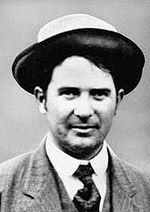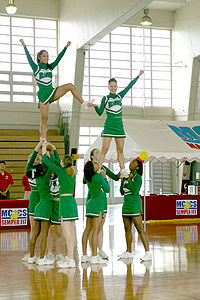Cheerleading
This article needs additional citations for verification. (June 2007) |

Cheerleading is a sport[1][2][3][4]that uses organized routines made from elements of tumbling, dance, and stunting to cheer on sports teams at games and matches, compete at cheerleading competitions, or both. The athlete involved is called a cheerleader. It is most common in North America, but has quickly spread elsewhere.[1]
History

Cheerleading first appeared in the U.S. in the late 1880s with the crowd chanting as a way to encourage school spirit at athletic events. The first organized, recorded cheer was yelled "Ray, Ray' Ray! TIGER, TIGER, SIS, SIS, SIS! BOOM, BOOM, BOOM! Aaaaah! PRINCETON, PRINCETON, PRINCETON!" at Princeton University in 1884.[5] A few years later, Princeton graduate, Thomas Peebles introduced the idea of organized crowd cheering and [American] football to the University of Minnesota. However, it was not until 1898 that University of Minnesota student Johnny Campbell directed a crowd in cheering "Rah, Rah, Rah! Sku-u-mar, Hoo-Rah! Hoo-Rah! Varsity! Varsity! Varsity, Minn-e-So-Tah!”, making Campbell the very first cheerleader and November 2, 1898 the official birth date of organized cheerleading.[5] Soon after, the University of Minnesota organized a "yell leader" squad of 6 male students, who still use Campbell's original cheer today.[5] Cheerleading started out as an all-male activity. Females began participating in the 1920s, due to limited availability of female collegiate sports. During this time, gymnastics, tumbling, and megaphones were incorporated into popular cheers. Today it is estimated that 97% of cheerleading participants are female, but males still makeup 50% of collegiate cheering squads. [6]

In 1948, Lawrence "Herkie" Herkimer, of Dallas, TX formed the National Cheerleaders Association (NCA) as a way to hold cheerleading clinics. In 1949, The National Cheerleaders Association held its first clinic in Huntsville, TX with 52 girls in attendance.[6] "Herkie" contributed many "firsts" to the sport including: founding the Cheerleader & Danz Team uniform supply company, inventing the herkie, (where one leg is bent towards the ground and the other is out to the side as high as it will stretch in the toe touch position)[7] and perfecting the "Spirit Stick".
By the 1960s, college cheerleaders began hosting workshops across the nation, teaching fundamental cheer skills to eager high school age girls.[5] In 1965, Fred Gastoff invented the vinyl pom pom and it was introduced into competitions by the International Cheerleading Foundation (now the World Cheerleading Association or WCA).[5] Organized cheerleading competitions began to pop up with the first ranking of the "Top Ten College Cheerleading Squads" and "Cheerleader All America" awards given out by the International Cheerleading Foundation in 1967.[5] In 1978, America was introduced to competitive cheerleading by the first broadcast of Collegiate Cheerleading Championships on CBS.[5] Around 1995, American Cheer and Cheers & More magazines debuted featuring articles on technique, upcoming events, routine ideas, resources for coaches and the latest cheer fashion.

In the 1960's National Football League (NFL) teams began to organize professional cheerleading teams. It was the Dallas Cowboys Cheerleaders who gained the spotlight with their revealing outfits and sophisticated dance moves, which debuted in the 1972-1973 season, but were first seen widely in Super Bowl X (1976). This caused the image of cheerleaders to permanently change, with many other NFL teams emulating them. Most of the professional teams' cheerleading squads would more accurately be described as dance teams by today's standards; as they rarely, if ever, actively encourage crowd noise or perform modern cheerleading moves.
The 1980s saw the onset of modern cheerleading with more difficult stunt sequences and gymnastics being incorporated into routines. ESPN first broadcasted the National High School Cheerleading Competition nationwide in 1983.[8]. Cheerleading organizations such as the American Association of Cheerleading Coaches and Advisors (AACCA) started applying universal safety standards to decrease the number of injuries and prevent dangerous stunts, pyramids and tumbling passes from being included in routines. [9] In 2003, the National Council for Spirit Safety and Education (NCSSE) was formed to offer safety training for youth, school, all star and college coaches. The NCAA requires college cheer coaches to successfully complete a nationally recognized safety-training program. The NCSSE or AACCA certification programs are both recognized by the NCAA.
Today, cheerleading is most closely associated with American football, and to a lesser degree basketball. Sports such as soccer, ice hockey, volleyball, baseball, and wrestling sometimes sponsor cheerleading squads. The Florida Marlins were the first Major League Baseball team to have cheerleaders. Debuting in 2003, the "Marlin Mermaids" gained national exposure and have influenced other MLB teams to develop their own cheer/dance squads.
According to latest statistics,[10] there are nearly 3 million cheerleaders in the USA alone, and half as many dance team members and gymnasts, taking the total number of participants involved in cheerleading and allied activities in the USA to above 5 million..[1] There are also tens of thousands of cheerleaders in Europe, Central America, Australia, and Asia.[1]
All Star Cheerleading
In the 1980s, cheerleading teams not associated with schools or sports leagues, whose main objective was competition, began to emerge. All-star cheerleading involves a squad of any number of females and/or males. The squad prepares year-round for many different competition appearances, but they only actually perform for up to 2½ minutes during their routines. The numbers of competitions a team participates in varies from team to team, but generally, most teams tend to participate in eight-ten competitions a year. During a competition routine, a squad performs carefully choreographed stunting, tumbling, jumping and dancing to their own custom music. Teams create their routines to an eight-count system and apply that to the music so the team members execute the elements with precise timing and synchronization.
Judges at the competition watch for illegal moves from the group or any individual member. Here, an illegal move is something that is not allowed in that division due to difficulty and safety restrictions. More generally, judges look at the difficulty and execution of jumps, stunts and tumbling, synchronization, creativity, the sharpness of the motions, showmanship, and overall routine execution.
All-star cheerleaders are placed into divisions, which are grouped based upon age, size of the team, gender of participants, and ability level. The age levels vary from under 4 year of age to 18 years and over. The divisions used by the USASF/IASF are currently Tiny, Mini, Youth, Junior, Junior International, Junior Coed,Senior, Senior coed, Open International and Open.[11]
Not only is competitive cheerleading popular throughout most of the United States, but in other nations as well. If a team places high enough at selected USASF/IASF sanctioned national competitions, they could be included in the USASF Worlds invitational and compete against teams from all over the world. Although each country is unique, overall the rules remain the same in order to maintain a level of fairness, if any competitor falls out of a stunt or mess up, points will be deducted.[1]
USASF World Cheerleading Championships
The foremost competition for all-star cheerleading is the annual USASF World Championships held at the Walt Disney World Resort in Orlando, Fla. Teams must qualify for the event by finishing at or near the top at one of several qualifying competitions. US teams have won the vast majority of the medals, but an increasing number of strong teams from around the globe have come to compete in the event in recent years. This competition has grown in popularity and prestige since it's beginning as a small competition in 2004. In 2007, over 100 teams from 15 different countries competed in the event.[1]
2004
2005
2006
2007
Worlds Medal Count by Program
| Program | Gold | Silver | Bronze | Total |
|---|---|---|---|---|
| Cheer Athletics | 4 | 4 | 0 | 8 |
| Gym Tyme | 4 | 0 | 0 | 4 |
| Stingrays | 2 | 2 | 0 | 4 |
| Spirit of Texas | 1 | 3 | 0 | 4 |
| Georgia | 1 | 1 | 1 | 3 |
| Maryland Twisters | 1 | 1 | 1 | 3 |
| Miami Elite | 2 | 0 | 0 | 2 |
| World Cup | 2 | 0 | 0 | 2 |
| Top Gun | 1 | 0 | 1 | 2 |
| Star Athletics | 0 | 1 | 1 | 2 |
| American Cheer | 0 | 0 | 2 | 2 |
| Cheer Extreme | 0 | 0 | 2 | 2 |
| Cheer Force | 0 | 0 | 2 | 2 |
| Kentucky Elite | 0 | 0 | 2 | 2 |
Little Scholars
Pop warner
Cheerleading in Popular Culture
Also see List of cheerleaders
Cheerleading's increasing popularity in recent decades has made it a prominent feature in high-school themed movies and television shows. The 2000 film Bring It On, about a San Diego high school cheerleading squad called "The Toros", was a surprise hit, earned nearly $70 million and spawned two sequels. It was followed in 2001 by another teen cheerleading comedy, Sugar & Spice. In 1993, The Positively True Adventures of the Alleged Texas Cheerleader-Murdering Mom was an acclaimed TV movie which told the true story of Wanda Holloway, the Texas mother whose obsession with her daughter's cheerleading career made headline news.
Many prominent people have been cheerleaders, including: Madonna, Paula Abdul, George W. Bush, Meryl Streep, Steve Martin, Halle Berry, Sandra Bullock etc.[12]
Nintendo has released a pair of video games in Japan for the Nintendo DS, Osu! Tatakae! Ouendan and its sequel Moero! Nekketsu Rhythm Damashii that star teams of male cheer squads, or "Ouendan" that practice a form of cheerleading unique to Japanese culture. Each of the games' most difficult modes replaces the male characters with female cheer squads that dress in western cheerleading uniforms. The games task the cheer squads with assisting people in desperate need of help by cheering them on and giving them the motivation to succeed.
See also
- List of cheerleading stunts
- List of cheerleading jumps
- List of cheerleaders
- National Football League cheerleading
- Ōendan, a style of Japanese cheerleading
References
- ^ a b c d e f "A World of Cheer!". Retrieved 2007-05-17. Cite error: The named reference "nw20007" was defined multiple times with different content (see the help page).
- ^ "The Most Dangerous Sports". Retrieved 2007-06-29.
- ^ "Cheerleading Injuries Increasing". Retrieved 2007-06-29.
- ^ "IASF home page". Retrieved 2007-06-29.
- ^ a b c d e f g "The History of Cheerleading". Retrieved 2007-08-06.
- ^ a b "Cheerleading – Oh How far it has come!". Retrieved 2007-01-11.
- ^ "Cheerleading Jump Herkie". Retrieved 2007-08-06.
- ^ [1] "Dansk Cheerleading"
- ^ "About the AACCA". Retrieved 2007-01-11.
- ^ [2] "Cheerleaders:The Ultimate Athletes!"
- ^ "USASF All-Star Cheer Divisions for 2007-2008" (pdf). Retrieved 2007-06-29.
- ^ "Famous Cheerleaders". Retrieved 2007-06-11.
External links
- National Council for Spirit Safety and Education (NCSSE)
- American Association of Cheerleading Coaches and Advisors (AACCA)
- National Cheerleading Association and National Spirit Group (NCA and NSG)
- United States All-Star Federation (USASF)
- International All Star Federation (IASF)
- British Cheerleading Association (BCA)
- UK Cheerleading Association (UKCA)
